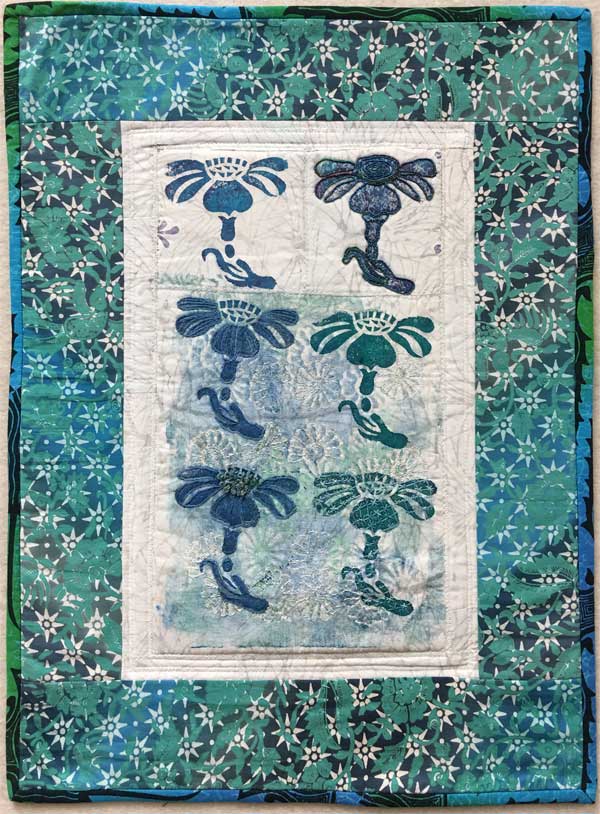In my last post I promised that I would conclude my stint as the March artist by showing off some of the quilts that I’ve made (alone or collaborating with other artists) using wooden printing blocks.
Several years ago Artistic Artifacts hosted the talented British textile artist Jamie Malden, owner of Colouricious, for a block printing workshop. Jamie’s time in town coincided with a visit from Liz Kettle of Textile Evolution, and so we dedicated some time to work collaboratively. Liz titled her blog post about this creative event “3 Artists + 3 Days = Creative Frenzy” — very apt!
The below quilt was created using the WB12 Orchid block and was bordered and bound with two of our Combanasi batiks, which feature silk screen motifs with traditional batik techniques (view larger image).
Several of the orchid prints were embellished with a variety of hand-stitches using Tentakulum Handpainted Fibers: see detail photo below.
Our dragonfly quilt features a print from the WB212 DragonflyDragonfly in Wetland square block as the center, accented with hand-dyed fibers and trim. It’s bordered by hand-dyed fabric block printed with a variety of paisleys and florals. (View larger image)
The below quilt uses our large leaf block with white PROfab Opaque Textile Paint, printed atop fabrics that were monoprinted using stencils, bubble wrap and more on a Gelli Arts™ Gel Printing Plate (view larger image). If you haven’t experimented with monoprinting on a Gelli plate, I want to encourage you to give it a try — such a fun surface design technique!
We used this quilt as the backdrop for our prize package photo. The center is the WB213 Primitive Peacock block on monoprinted fabric, surrounded by fabric collage (monoprints, stamped, etc.) and stitched to a hand-dyed vintage linen piece. The base of this quilt is a hand-dyed commercial black & white fabric; I collect black & white fabrics specifically to dye them! The quilt was accented with beading (view larger image).
In my last post I gave you a glimpse of working on Lutradur to create snowflakes. Visit the Artistic Artifacts blog to learn more about the creation of this quilt. Below is the finished quilt (view larger image).
The below is the final assembled result that came after I was inspired by a demonstration during one of our monthly art group meetings. That demo led to a LOT of new fans of the process, all putting their own spin similar little hand-stitched quiltlets.
While I did make some new pieces for this one, the majority of the block prints were collected from the many, many wood block demonstrations I’ve held over the years; in my shop, at quilt shows, etc. I really enjoyed giving these a ‘home’ and having the individual pieces be a portable hand-stitching project (until the final stitching together). Visit the Artistic Artifacts blog for more on my Slow Stitched Outsider Art Quilt, including links to tutorial videos by Teesha Moore.
Last Chance: Leave a Comment for Your Opportunity to Win!
One lucky U.S.-based winner will be randomly drawn from the list of all who have commented on these March block printing postings. Comments will be tallied here on The Printed Fabric Bee blog, as well as on my Artistic Artifacts blog.
My prize package is pictured above: a gorgeous circle design wooden printing block, a foam printing mat, and a jar of PROfab Opaque Textile Paint in the color True Blue.
BUT, if you live near Artistic Artifacts, or are willing to travel to us, you instead have the option to attend my Woodblock Printed Art Quilt class on June 11 for free if you prefer!
The winner will be drawn and notified on Tuesday, April 5th. Good luck to everyone! I’ve enjoyed sharing my wooden printing blocks enthusiasm with you all.

























